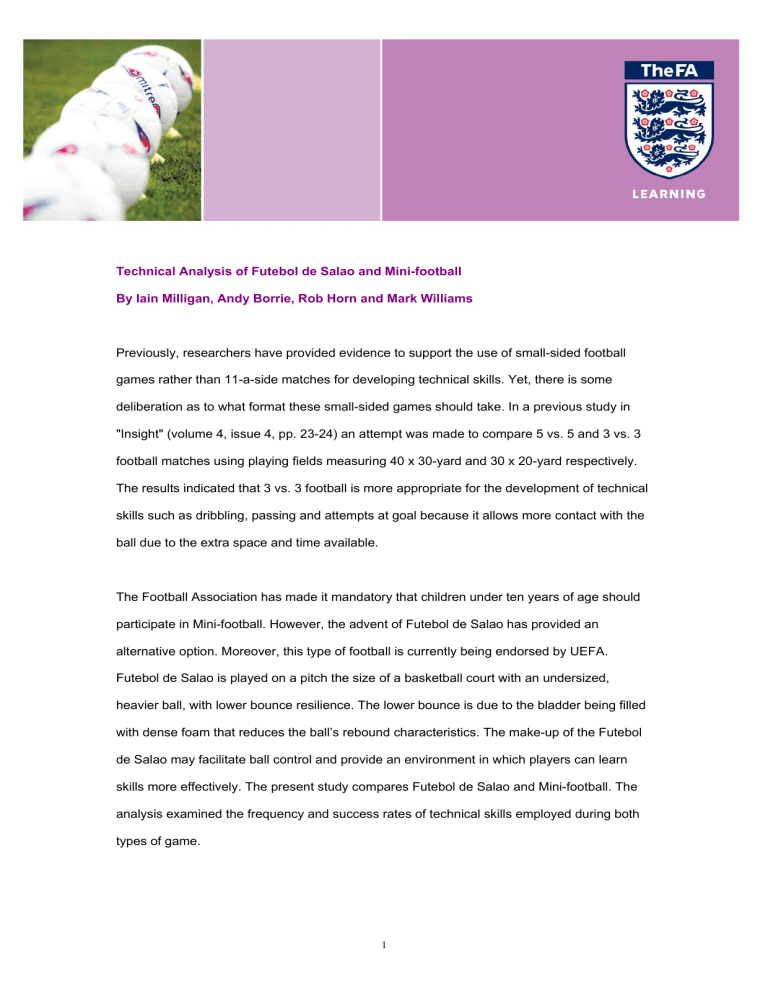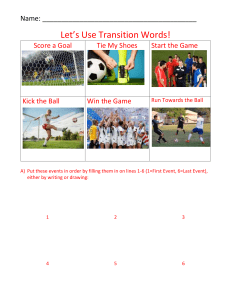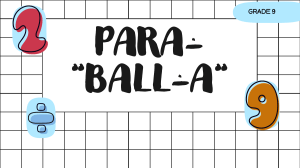
Technical Analysis of Futebol de Salao and Mini-football
By Iain Milligan, Andy Borrie, Rob Horn and Mark Williams
Previously, researchers have provided evidence to support the use of small-sided football
games rather than 11-a-side matches for developing technical skills. Yet, there is some
deliberation as to what format these small-sided games should take. In a previous study in
"Insight" (volume 4, issue 4, pp. 23-24) an attempt was made to compare 5 vs. 5 and 3 vs. 3
football matches using playing fields measuring 40 x 30-yard and 30 x 20-yard respectively.
The results indicated that 3 vs. 3 football is more appropriate for the development of technical
skills such as dribbling, passing and attempts at goal because it allows more contact with the
ball due to the extra space and time available.
The Football Association has made it mandatory that children under ten years of age should
participate in Mini-football. However, the advent of Futebol de Salao has provided an
alternative option. Moreover, this type of football is currently being endorsed by UEFA.
Futebol de Salao is played on a pitch the size of a basketball court with an undersized,
heavier ball, with lower bounce resilience. The lower bounce is due to the bladder being filled
with dense foam that reduces the ball’s rebound characteristics. The make-up of the Futebol
de Salao may facilitate ball control and provide an environment in which players can learn
skills more effectively. The present study compares Futebol de Salao and Mini-football. The
analysis examined the frequency and success rates of technical skills employed during both
types of game.
1
Methodology
•
The matches analysed featured 9-10 year old non-elite male players.
•
A video camera was used to record the matches from a position at ground level near the
halfway line and touch line.
•
The camera followed the movement of the ball and the immediate surrounding action for
the duration of the game.
•
The videotapes were replayed on a television monitor and a hand-notation system was
used to analyse the activities of the player in possession of the ball.
•
Futebol de Salao and Mini-football matches were played on regulation pitches in
accordance to the laws of the UK Confederation of Futebol de Salao and the guidelines
for Mini-football provided by the Football Association.
•
Six Futebol de Salao and six Mini-football matches were analysed.
•
All matches featured the same players and teams in both game formats.
•
Table 1 shows the format of the matches.
Definitions
•
Passes under 10 m, between 10-20 m and over 20 m were classified as short, medium
and long passes respectively.
•
A ground pass occurred when the ball did not leave the playing surface. A high pass
resulted when the ball left the playing surface.
•
A pass was deemed to be
unsuccessful if the next player to
touch the ball was an opponent and
successful if a team-mate received
the ball
•
A successful attempt at goal was an
effort that was on target and saved by
the goalkeeper or the last line of
defence. An unsuccessful shot was
an attempt at goal that was off target,
2
or was blocked either before the goalkeeper saved, or before the last line of defence.
Results
Passing Techniques
The average number of all passes attempted (168 ± 25) and the overall success rate (76%)
were higher during Futebol de Salao compared with Mini-football matches (148 ± 18, 71%).
The data presented in Table 2 and Figure 1 indicate that Futebol de Salao matches featured
more short and medium range ground passes and had fewer long range and high passes.
The consequence of this was that players were more successful in passing and controlling
the ball. The small, heavy ball appears to limit the player’s ability to kick the ball any great
distance or to lift the ball off the ground and the smaller size of the playing area demands
greater passing accuracy. The findings suggest that Futebol de Salao matches help improve
passing technique by encouraging players to be precise and to play the ball on the floor.
Attempts at Goal
There were more attempts at goal during Futebol de Salao (62 ± 9) compared with Minifootball matches (46 ± 2). As a result there were more shots on target and goals scored
(Table 3). The greater number of chances in Futebol de Salao could be due in part to the
smaller playing area or, alternatively, the heavier and less resilient ball may facilitate good
passing, control and dribbling. A further potential benefit of Futebol de Salao is that the goals
are smaller than those employed in Mini-football, thereby encouraging shooting accuracy (see
Table 1).
Individual Play
The data presented in Figure 2 and Table 3 illustrate that Futebol de Salao matches allowed
players to accomplish all of the individual techniques more frequently (mean total of 236 ± 9)
and successfully (84%) compared to Mini-football (182 ± 21 and 79%, respectively). Due to
the lower rebound resilience, the Futebol de Salao ball was in the air less often and this might
have led to an increase in the number of touches for the players, evidenced by the greater
3
number of techniques
attempted. The smaller size of
the court and the tight
proximity of opponents help
players to develop close ball
control and emphasise skilful
dribbling.
Turnovers of Possession
Possession was regained from open play more often by interception of passes than by
tackling in both types of game. This suggests that there is more emphasis on skill (i.e.,
anticipating the intention of the opposing player and the developing pattern of play) rather
than physical contact through tackling. As a result of the ball being on the ground more, both
types of turnover were performed more frequently in Futebol de Salao (107 ± 16) than in Minifootball (84 ± 16). As such there were more opportunities to learn defensive skills such as
tackling and support.
Analysis of Set Plays
Table 2 shows that there were a similar number of set-plays awarded in both match formats.
However, a larger overall percentage of set-plays were performed successfully during Futebol
de Salao (74%) compared with Mini-football (61%). Rule modifications in Futebol de Salao
state that when the ball goes over the sideline it should be kicked into play rather than thrownin as with Mini-football. The success rate of this was 80% compared with 65% for throw-ins
during Mini-football (see Figure 1).
Technical Skills Performed by Goalkeepers
The involvement of goalkeepers in both small-sided games is highlighted in Table 4 and
Figure 3. There were more goalkeeping actions performed during Mini-football matches (93 ±
11) than in Futebol de Salao (86 ± 11). In particular Mini-football provided more opportunity to
develop catching and kicking skills due to the ball being in the air more often. The greater
4
frequency of shots on target during Futebol de Salao allowed goalkeepers slightly more
opportunity to make saves in comparison with Mini-football. The manner in which the
goalkeeper distributed the ball varied between the two formats. The rules of Futebol de Salao
state that the ball is not allowed to cross the halfway line without touching the floor or being
played by a team-mate. This rule forced the goalkeeper to throw-out or pass along the ground
more often resulting in better retention of possession.
Summary and Conclusions
When compared with Mini-football matches, Futebol de Salao games:
•
Allow players to perform more individual techniques;
•
Feature more successful passes, controls, fakes and feints, dribbles and runs with the
ball;
•
Provide more attempts at goal leading to more goals being scored;
•
Provide goalkeepers with greater opportunities to make saves;
•
Have more successful set-plays due to rule modifications.
The results from this study indicate that Futebol de Salao provides players with greater
opportunities to perform basic football techniques compared to Mini-football. It is suggested
that more effective participation through increased ball contact accelerates the acquisition of
technique.
Although there were differences in the size of the playing area, goalposts and modifications to
the rules that contributed to
the results, the main factor
between the two games
appeared to be the ball’s
size, weight and resilience.
These factors allow greater
control of the ball,
culminating in a playing
5
environment in which players can develop key skills. As such the ball helps to develop
techniques that apply not only to Futebol de Salao, but could transfer to conventional football.
It is difficult to determine whether the smaller ball, the reduction of the ball bounce or both
lead to the greater success rates. Further analysis is required to examine the effects of
different ball characteristics on small-sided games. The significance of the number of players,
the size of the field and goalposts, and different rule modifications need to be examined in
isolation to try and determine the best small-sided game structure needed for children to
experience success, which contributes to the skill proficiency.
Further Reading
Davids, K. & Chapman, G. (2001). Adapting equipment to children’s development:
Does the Futebol de Salao lead to better acquisition of skill than regular balls?
Insight: The Football Association Coaches Journal, vol.4, 4, 38-39.
Grant, A., Williams, A.M., Dodd, R., and Johnston, S. (1999). Physiological and
Analysis of 11 v 11 and 8 v 8 Youth Football Matches. Insight: The
Technical
Football Association
Coaches Journal, vol 2, 3, (Spring 1999) p. 29-30.
Platt, D., Maxwell, A., Horn, R., Williams, M., and Reilly, T. (2001). Physiological and
Technical Analysis of 3 v 3 and 5 v 5 Youth Football Matches. Insight:
The Football
Association Coaches Journal, vol. 4, 4, (Autumn 2001) p. 23-24.
Williams, A.M. (2000) Transfer of learning in football: From juggling to ball control. Insight: The
Football Association Coaches Journal, 4, 4, 30-31.
Iain Milligan is a graduate of Liverpool John Moores University in the area of coaching
science.
6
Andy Borrie, previously a member of staff at Liverpool John Moores University, is now
based at Loughborough University. He has worked as a performance analyst with
several national sports squads.
Rob Horn is an Assistant Professor in the Department of Physical Education,
Montclaire State University, New Jersey, USA. He completed his doctoral degree in the
area of motor learning at Liverpool John Moores University in 2002.
Mark Williams is Professor of Motor Behaviour at the Research Institute for Sport and
Exercise Sciences, Liverpool John Moores University.
7
Match Format
Futebol de Salao
Mini-football
Number of Players
5v5
5v5
Duration
2 x 15 minutes
2 x 15 minutes
Length of Field of Play
30 metres
35 metres
Width of Field of Play
17 metres
20 metres
Height of Goalposts
2 metres
1.8 metres
Width of Goalposts
3 metres
3.6 metres
Size of Football
2
4
Weight of Football
465g
445g
Rebound Resilience
10-15%
42-48%
Offside Rule Applied
No
No
Table 1. Structure of Futebol de Salao and Mini-football matches.
Type of Pass/Set Play
Average Frequency per
Game in Futebol de Salao
Average Frequency per
Game in Mini-football
Short-ground Pass
137.7
97.2
Short-high Pass
10.5
24.5
Medium-ground Pass
16.2
14.5
Medium-high Pass
2.2
7.8
Long-ground Pass
1.5
1.8
Long-high Pass
0.3
1.8
Throw/kick-in
23.3
26.3
Corner
9.3
9.3
Free Kick
2.5
0.2
Penalty
0.3
0.0
Table 2. Average frequency of passes and set plays per game in Futebol de Salao and Minifootball.
8
Individual Technique or
Action
Average Frequency per Average Frequency per
Game in Futebol de
Game in Mini-football
Salao
Control
Dribble
Run with Ball
Turn with Ball
Fake/feint
Interception
Tackle
131.7
38.6
25.8
23.3
16.3
68.0
39.3
111.2
26.7
21.0
15.7
7.7
51.3
32.5
Successful Attempt at Goal
Unsuccessful Attempt at Goal
Goals
46.3
15.2
16.0
33.3
12.6
10.2
Table 3. Average frequency of individual actions, attempts on goal and goals scored per
game in Futebol de Salao and Mini-football.
Goalkeeping Action
Average Frequency per
Game in Futebol de Salao
Average Frequency per
Game in Mini-football
Saves
28.2
25.7
Catches/collects
7.2
14.3
Kicks from Hand
0.5
7.7
Kicks from Ground
19.8
17.0
Goal Kicks
15.3
16.7
Throws
14.5
11.2
Table 4. Average frequency of goalkeeping actions per game in Futebol de Salao and Minifootball.
9
Futebol de Salao
100
Mini-soccer
90
Success Rate (%)
80
70
60
50
40
30
20
Free-kicks
Corners
Throw/kick-ins
Long/High
Long/Ground
Medium/High
Medium/Ground
Short/High
0
Short/Ground
10
Type of Pass or Set Play
Figure 1. Success Rates for Passes and Set Plays in Futebol de Salao and Mini-football.
Success Rate (%)
Futebol de Salao
100
95
90
85
80
75
70
65
60
55
50
Mini-soccer
Control
Dribble
Run with
Ball
Turn with
Ball
Fake/feint
Individual Technique
Figure 2. Success Rates for Individual Techniques in Futebol de Salao and Mini-football.
10
Futebol de Salao
Goal-kicks
Kicks from
Ground
Kicks from
Hand
Throws
100
90
80
70
60
50
40
30
20
10
0
Catches/collects
Success Rate (%)
Mini-soccer
Goalkeeping Technique
Figure 3. Success rates for goalkeeping actions in Futebol de Salao and Mini-football.
11


